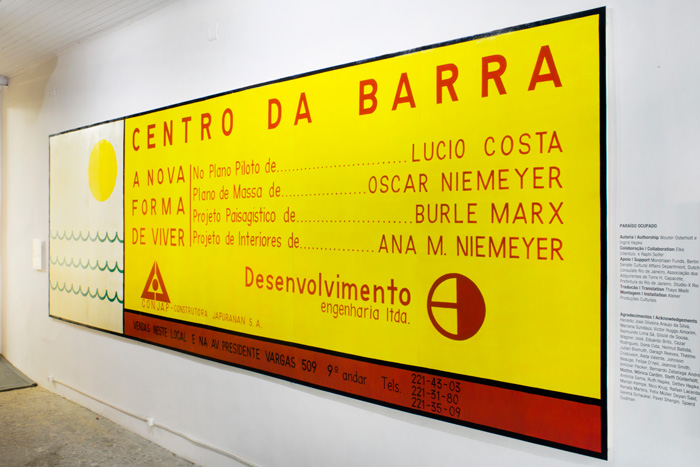Artist:
Wouter Osterholt (born 1979 in Leiden, the Netherlands) and Elke Uitenuis (born 1977 in Sneek, the Netherlands).
Description:
“(Portuguese for ‘Occupied Paradise’) is a reconstruction of a failed modernist plan for an urban center located in the West zone of Rio de Janeiro. This plan, designed by Oscar Niemeyer, was officially approved in 1970 and served as inspiration for Lúcio Costa’s Pilot Plan for the greater region. All the documents in the exhibition are part of an abandoned archive found in the ruin of one of the three actually constructed circular towers. A website with the digitalized documents was launched with the exhibition, so the material became accessible to the public. This precedes the ultimate objective of Paraíso Ocupado: the establishment of a museum concerned with the urbanization history of Barra da Tijuca.”
—”Paraíso Ocupado,” website of Wouter Osterholt.
“This exhibition is a long-term research project, which aims to revisit and reconstruct the master plan Centro da Barra, later known as Athaydeville, an urban center located in Barra da Tijuca, in the Westzone of Rio de Janeiro. This plan, designed by Oscar Niemeyer, was officially approved in 1970 (he had worked on it for three years) and served as inspiration for Lúcio Costa’s Pilot Plan for the greater neighborhood in the lowlands of Jacarepaguá (1969).
“Centro da Barra was designated a modernist infrastructure with 71 circular residential towers and public facilities situated among tropical gardens designed by Roberto Burle-Marx. This residential area, which was not divided by walls or fences, was planned to accommodate a wide range of income and families of different sizes. Lúcio then projected these urban centers on a larger scale throughout the lowlands.
“Without strict state control Barra da Tijuca turned into an urban ‘El Dorado’ for real estate developers and the guidelines of the masterplan were eventually disregarded. Development began in the early 1970s, but paused repeatedly amid rampant speculation, unfocused politics and obscure business affairs, until the project was finally discontinued in 2005.
“From a diversified, eco-friendly neighborhood on the drawing board to a fortress of gated communities and traffic turmoil in reality, Barra da Tijuca’s urban development and the failure to implement the masterplan are marked by the closure of Brazilian modernism.
“Ever since 2010, when Rio de Janeiro was announced host of the 2016 Olympics, Barra has been promoted and developed as its epicenter. And it seems that history repeats itself: land prices have peaked, favelas have been forcefully removed and the region is again (in similar ways as in the early seventies) being sold as the new paradise.
“The models and unpublished documentation material exhibited here bring to light the singularities of Barrada Tijuca’s urbanization. The documents are part of an abandoned archive found in the ruins of one of the three towers, that were actually built. Parallely, a website (www.paraisoocupado.com) with the digitalized documents is being launched in order to raise awareness and to make this material accessible to the public. With this exhibition, Wouter Osterholt and Ingrid Hapke, take a first step towards the establishment of a future museum dedicated to the history of Barra da Tijuca’s urbanization.”
—”Paraíso Ocupado,” Columbia GSAPP, 2016.


